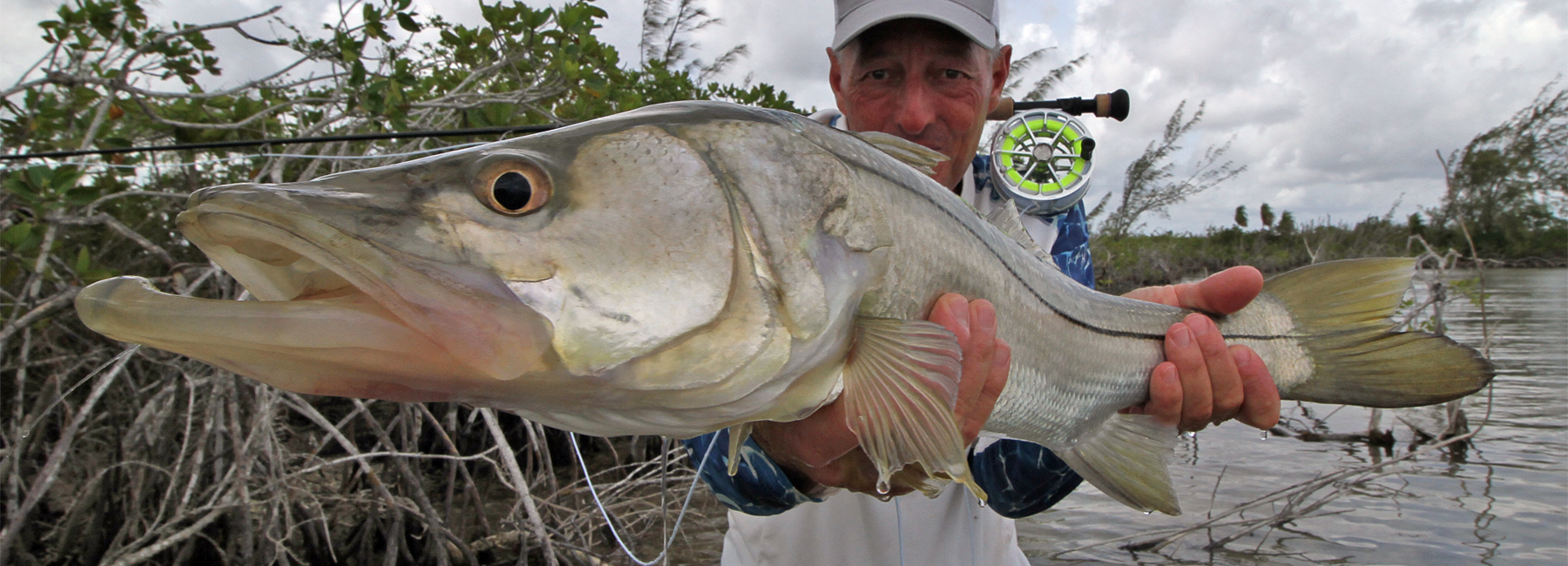Top 5 Snook Destinations
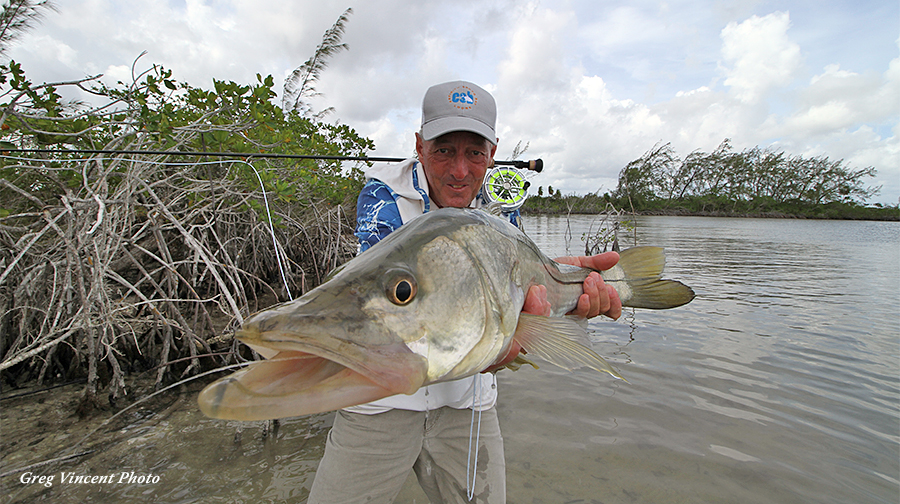
Espiritu Santo Bay Lodge:
Espiritu Santo Bay Lodge (ESB), is a wilderness flats fishing destination specifically designed for serious saltwater fly fishers. ESB sits on a beautiful Caribbean beach in the southernmost part of Mexico’s Yucatan Peninsula, just south of the sleepy lobster fishing village of Punta Herrero and within the massive 1.3 million acre Sian Ka’an Biosphere Reserve. This is a remote wilderness flat fishing destination, 250 road miles from the mega resort metropolis of Cancun – the lost flats of the Caribbean!
The Experience:
There are simply very few places left in the world with the same sort of unspoiled natural resources found in ESB. Robust and healthy populations of bonefish, permit, tarpon, and snook abound in its flats, creeks, and backcountry lagoons. And nobody has better access to or more intimate knowledge of the bay than the guides at Espiritu Santo Bay Lodge, who have spent years guiding there.
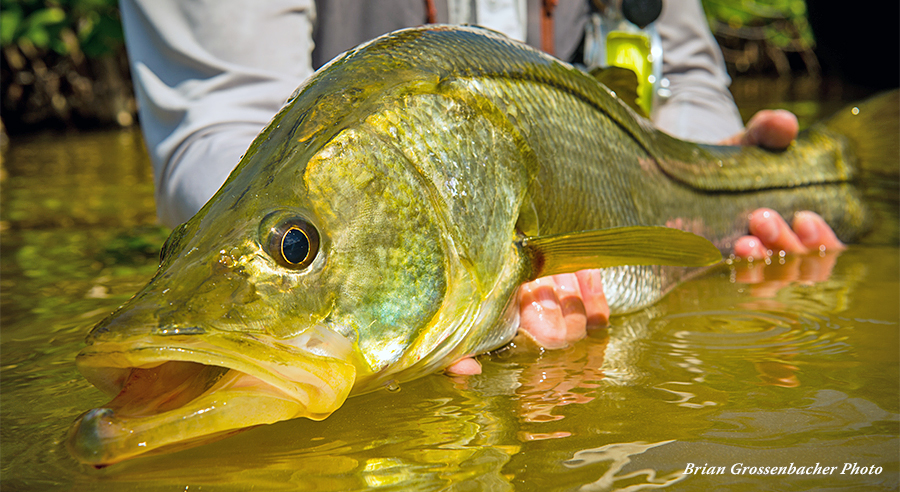
Playa Blanca:
Playa Blanca is a beautiful full service resort located on a secluded white sand beach with several guest bungalows and a central lodge for meals, meetings and cocktail hours. Playa Blanca is located 10 miles south of Casa Blanca (its sister lodge) on Isla Punta Pajaros. Playa Blanca offers world class facilities, a solid fishing program and is a perfect venue for anglers, non-anglers and inclusive groups and families.
The Experience:
At Playa Blanca you have access to one of the saltwater jewels, spectacular fly fishing frontier, Espiritu Santo Bay. Espiritu Santo Bay is shared with only one other licensed lodge, that being Espiritu Santo Bay Lodge located to the south of the Bay. Laguna Santa Rosa is famous for its year round juvenile tarpon population as well as some excellent bonefishing and occasionally some great snook fishing.
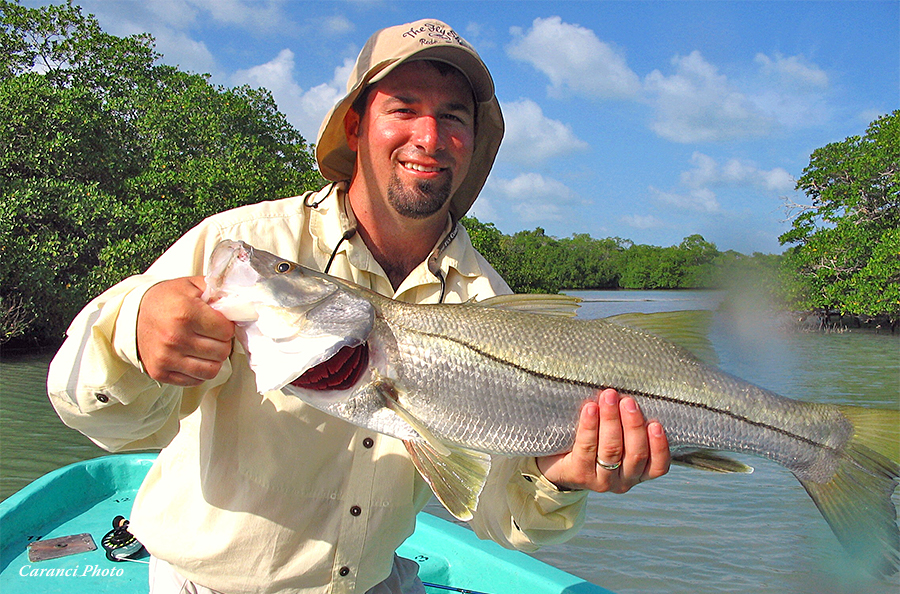
Belize River Lodge:
Belize River Lodge (BRL) is a tried and proven world-class fishing operation and has been in continuous operation since 1961. It is unique in that it offers anglers an incredible variety of different angling opportunities, including the lodge program the Long Caye Outpost. One thing is for sure, no matter what angling option you choose, the owners of BRL, Mike Heusner and Marguerite Miles, are wonderful, hard working, helpful people and run a top-notch operation. Their seasoned staff is among the best we have ever experienced and their work ethic is second to none in all the Caribbean. Non-angling activities are numerous, ranging from snorkeling to Mayan ruin tours. Boat tours and birding tours can be arranged for you and/or your partner as well as many other activities.
The Experience:
Belize River Lodge is appropriately named as it sits right on the banks of the Belize River – a lazy and meandering tropical waterway, minutes from the international airport. The lodge can accommodate 16 guests at one time, and is surrounded by lush tropical gardens, and well manicured lawns. Air orchids hang from the ancient mahogany trees interspersed among the buildings. The setting at the lodge is truly beautiful, like something out of a Tarzan movie. It’s not uncommon to hear clans of howler monkeys deep in the jungle calling to one another and see large Iguanas making their way across the grounds.
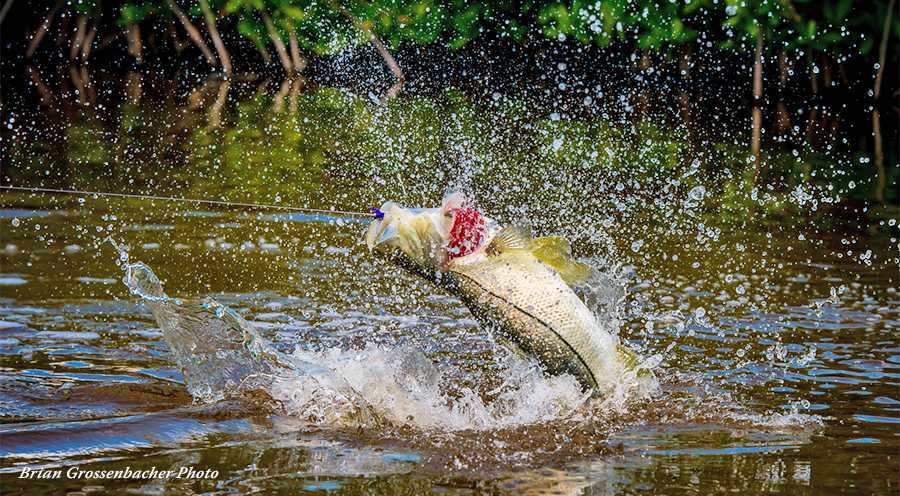
Casa Blanca:
If one were to dream up the perfect location for a saltwater flats fishing lodge, it would be hard to find one better than on the private island of Punta Pajaros directly between Ascension Bay and Espiritu Santo Bay in the Mexican Yucatan (south of Cancun) in the middle of the Sian Ka’an Biosphere.
The Experience:
The areas in both Ascension and Espiritu Santo Bays are so vast that there is nearly always a good place to fish on any given tide and phase of that tide.
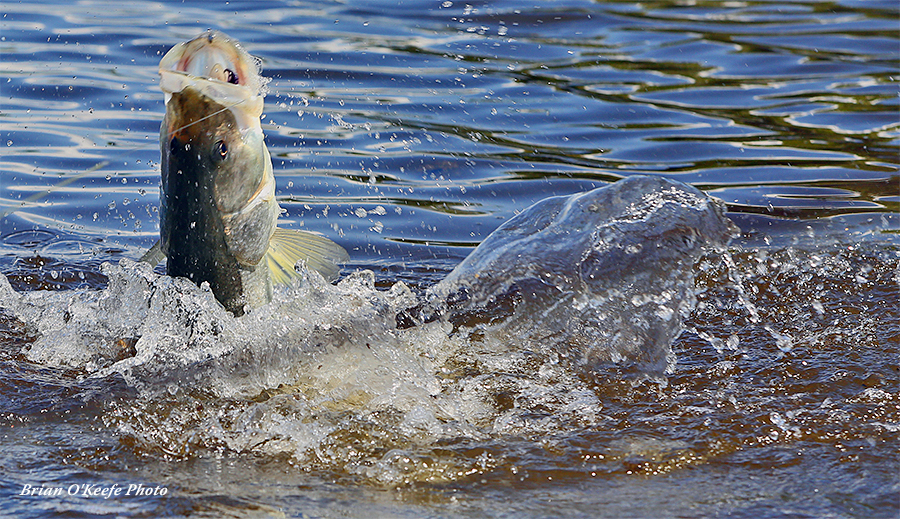
Canarreos, Cuba:
The Cannereos region of Cuba which encompasses Jardines de la Reina (Gardens of Queen), Is de la Juventud (Island of Youth) Cayo Largo (Long Key), and Cayo Romano is a multi species flats fishing destination that includes an abundant population of snook. All of these regions are part of the Blue Sanctuary a progressive conservation program initiated by the Cuban Government 27+ years ago to protect vulnerable and important marine areas. Commercial fishing within this designated area is strictly forbidden and rigorously enforced. The snook live here as they have for thousands of years and are a major target of the Canneros fishing program every day of the season. You’ll find snook in their usual haunts, including backwater mangrove wetlands, offshore reefs as well as on the flats. On warm days snook will move to deep channels and passageways bordering or bisecting skinny water flats where they ambush bay anchovy, pinfish and sand perch.
The Experience:
Foam bodied gurglers, cupped face poppers and crease flies draw these backcountry dwellers out from the mangrove lined shorelines, attacking flies with ruthless abandon. After a morning in the backcountry with the sun climbing into the sky, your guide swiftly maneuvers his skiff through a seemingly endless maze of twisting channels, and flats where you will intercept foraging snook, casting a Puglisi Pinfish pattern to them. It’s an exhilarating sight-fishing experience worthy of any saltwater fly fishing enthusiasts.
Centropomus undecimalis, Snook
by Eric Ersch
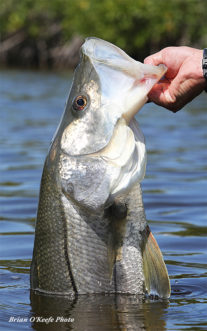 Snook have always been a mysterious fish to me. We didn’t have them in my ocean as a young man, only swimming through stories I’d read in outdoor mags. When I hooked my first ones on the west coast of Mexico, I didn’t even know they were snook. All I got back after the hook up was a leader that looked like it had been rubbed on a wood file —- a hard take, followed by a strong run, and then….. slackline. A couple surfers from Florida had one in their cooler, hooked on a yellow Mirrolure with a red head. I looked at it with great interest, being the first one I’d seen up close. Local fishermen had walked down the beach at our surf break with massive fish in their grip, tails dragging in the sand. I had no idea how to hook and land one there, and never did.
Snook have always been a mysterious fish to me. We didn’t have them in my ocean as a young man, only swimming through stories I’d read in outdoor mags. When I hooked my first ones on the west coast of Mexico, I didn’t even know they were snook. All I got back after the hook up was a leader that looked like it had been rubbed on a wood file —- a hard take, followed by a strong run, and then….. slackline. A couple surfers from Florida had one in their cooler, hooked on a yellow Mirrolure with a red head. I looked at it with great interest, being the first one I’d seen up close. Local fishermen had walked down the beach at our surf break with massive fish in their grip, tails dragging in the sand. I had no idea how to hook and land one there, and never did.
Flash forward ten years and I’m poling a skiff for redfish on Florida’s east coast, with the Space Center on the horizon. On flats fishing days plagued with clouds, showers and wind, I’d learned how not to lose a day’s income by poling sports along complex shorelines inside the inlet, jerking baitfish patterns along ambush points and catching small snook. But those fish were babies compared to the beasts that seasoned anglers caught, with their knowledge sealed behind tight lips. As the years went by, I’d earned enough respect to gain the confidence from Dick, a local surf legend and super savvy snook angler. We shared the same sandy launch ramp cut through the mangroves, often meeting there at the end of the day’s fishing. He tuned me into the annual patterns of travel that a snook lives throughout the year, and specifically the food that they preferred during the seasons. The jumbo shrimp they ate on an outgoing tide in the spring wouldn’t buy a bite when they were feasting on croakers in the fall.
Difficult to fool into putting a hook into their mouth, big snook are way harder to bring to the boat than any other flats and backcountry fish I know of. They eat flies, even surface poppers and gurglers, when they’re in the mood. They jump, pull hard, and beat you in the structure. Ya, you can pull some adolescents out from under a dock, typically young and aggressive, and easy to muscle into open water with an eight weight. But the game definitely changes when that fish exceeds fifteen pounds, becomes a highly selective feeder, and travels a well known waterway in search of good food and cover.
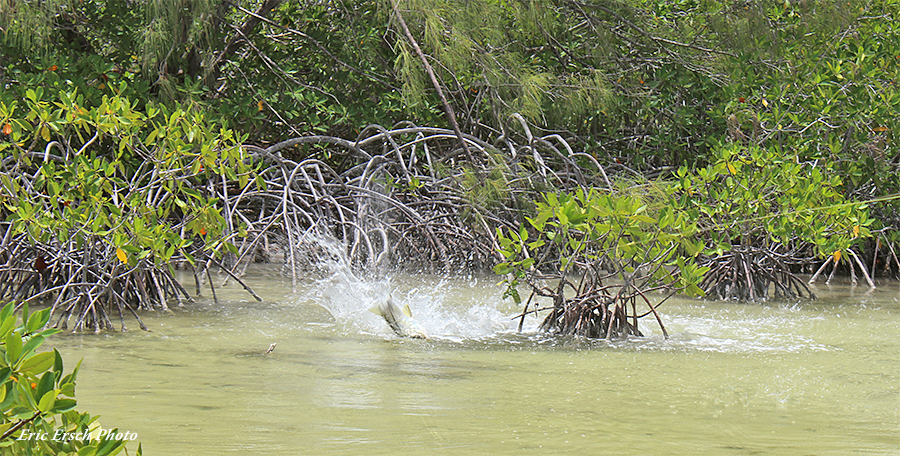
Big snook are finicky ambush feeders, with lips like coarse sand paper, and gill plates studded with razor sharp cutters. Hooking one is just the first part of the event. They fight with a lot in their favor, typically utilizing underwater structure as a hiding place for ambush, as well as the best place around to destroy your line. To hook and release a truly big snook is a valid angling accomplishment, one you will never forget.
With their love of warm water, snook inhabit some of the most exotic fishing locations in the world. Living with snook means humid tropical nights, palm trees, and all that goes with it. Florida has undoubtedly the best snook fishery in the lower 48, with healthy populations on the southern half of both coasts, and deep into the Everglades. With regulations in place to protect them, including a closed season during their summer spawn and through the coldest winter months, their only severe threat is a freezing cold front from the north that continues for days.
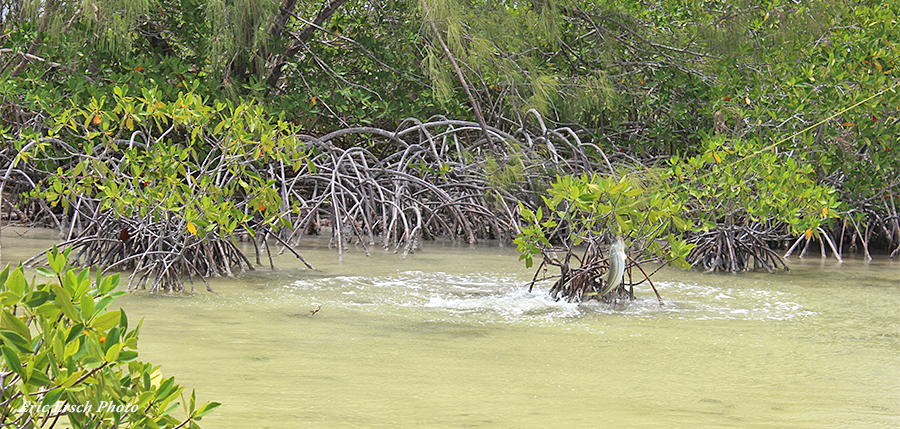
We’d been fishing this island point cluttered with dead tree limbs for a couple years. Just south of the inlet, surrounded by four feet of water, it was an apex predator feeding location. Mullet swam nervously along the sandy beach to the east, doing their best to avoid herons silently waiting for their mistake. To the west it broke to a shallow grassy flat, home to a variety of baitfish and shrimp,with a sharp edge falling into deeper water. We’d hooked redfish, sea trout, and jack crevalle there, and the occasional fifteen to twenty inch snook, but never a big one. My sport was fishing well, picking apart all the little nooks and crannies with well placed casts. With a bright silver flash, a serious snook lashed out from under the limbs and inhaled the streamer. We’d fished together for years, becoming close friends both on the skiff and ashore, and we fished together with confidence. Through trial and error, Charlie and I had learned the snook drill together, with way more losses than wins. Strip set, and the rod immediately goes down and hard to the side, away from the direction that the snook is headed. And, apply as much pressure as possible on the palming rim without breaking the leader. There is no “getting on the reel” with these fish. That moment of light tension as you reeled the line up off the deck only resulted in the fish swimming back into the structure, and… game over.
Poling hard, out and away from the structure, I’m doing my part to keep the fish from beating us in the brush. Charlie was on his game, and our plan worked that time. The fish now swam away from the sunken limbs, moving along the drop off edge of the grassy flat towards deeper water. Charlie gained some line as I poled well over fifty yards, following the fish to the west. Feeling confident, we stayed with the fish, knowing that we had open water on our side, and that we’d get this one after years of losing the battle. In a split second, the fish turned hard and to the left, streaking in front of the bow between us and the flat, unstoppable as the line peeled off of Charlie’s reel. With what seemed to be little effort, that snook power drove right through the limbs from which we’d hooked him, shredded the leader into pieces on sharp barnacles, and swam off to well deserved freedom.
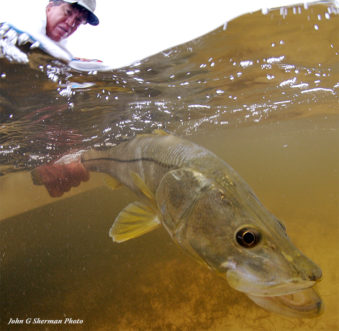 Snook live in a variety of locations throughout the year, punctuated by a spawning phase during the warm summer months. They congregate to spawn where backcountry waters meet the ocean, typically an inlet or rivermouth, broadcasting their future to be spread into the mangrove estuary for their early years of survival. All snook hatch with the beginning gender of male, and between one to seven years the majority switch to females. Winter often finds them in deeper backcountry channels, less affected by cold north winds than the shallow flats. Moving from their winter haunts, they feed on small fish, shrimp and crabs along mangrove clad shorelines, moving out onto the flats and into channels leading to coastal inlets through the spring.
Snook live in a variety of locations throughout the year, punctuated by a spawning phase during the warm summer months. They congregate to spawn where backcountry waters meet the ocean, typically an inlet or rivermouth, broadcasting their future to be spread into the mangrove estuary for their early years of survival. All snook hatch with the beginning gender of male, and between one to seven years the majority switch to females. Winter often finds them in deeper backcountry channels, less affected by cold north winds than the shallow flats. Moving from their winter haunts, they feed on small fish, shrimp and crabs along mangrove clad shorelines, moving out onto the flats and into channels leading to coastal inlets through the spring.
Heading south, the Yucatan peninsula of Mexico has miles of protected snook habitat, notably inside the Sian Ka’an Biosphere Reserve, south of Cancun. The important combination of immense mangrove estuaries and minimal shoreline development provides superb water quality. Combine that pristine habitat with reliable tidal influence through multiple inlets from the estuaries to the ocean, and you have everything a healthy population of snook needs to survive. Occasional cold fronts do blow down from the north during the winter, but never long and cold enough to hurt the resident population. For a dedicated snook angler, this region could be nirvana.
Charlie eventually landed a massive snook while fishing for tarpon, deep in the Everglades. Armed with an eleven weight, he spotted the fish feeding out on the flats and well away from any structure. Charlie knew the game, and Bill, with decades of experience, handled the skiff perfectly. Never removed the water, the snook measured out in world record proportions. Photographed and revived, she swam away from the skiff and back into her world. Charlie phoned me that evening, him relaxing in the “glades” sipping a rum and lime, and me in Alaska after a day’s work. We talked about the snook that had beat us over the years, and how lucky he was to meet that day’s fish in open water. He never “got it on the reel”, fighting it ‘mano y mano’, all the way to the boat.


